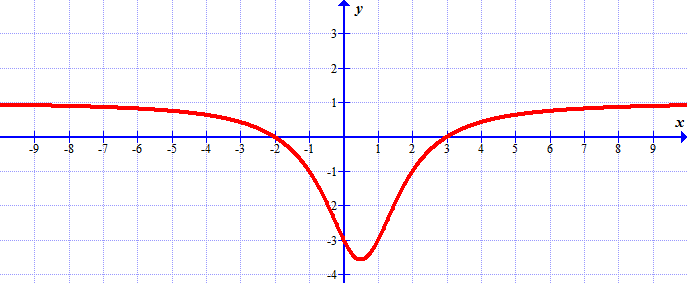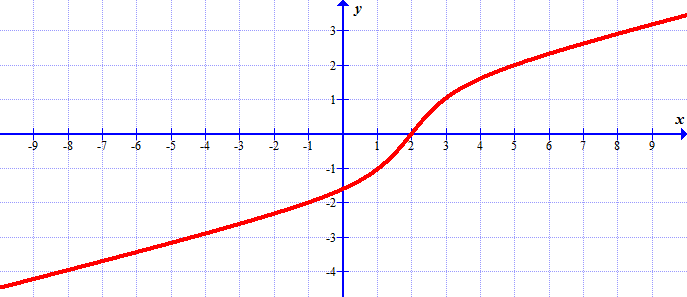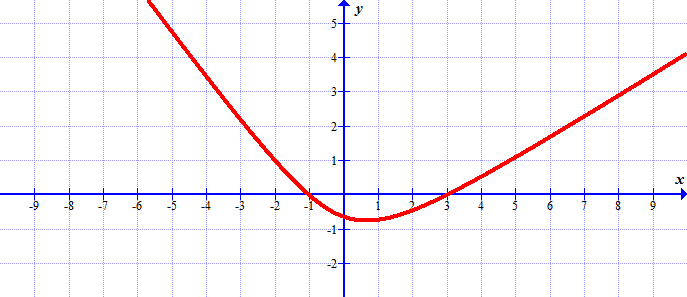
(a) Find the zeros of this function.
(b) Using the derivative find the stationary points of this function.
(c) Draw the graph.
Solutions: (a) \(x_1=-2,~ x_{2,3}=0,~ x_4=2\); (b) \(P_1(-\sqrt{2},-4),~ P_2(0,0),~ P_3(\sqrt{2},-4)\)(a) Calculate the derivative of this function.
(b) Hence find the stationary points of this function.
(c) Draw the graph using your GDC and verify the obtained result.
Solutions: (a) \(f'(x)=3x^2+6x+3\); (b) \(P_1(-1,1)\)(a) Calculate the derivative of this function.
(b) Hence find the stationary points of this function.
(c) Draw the graph using your GDC and verify the obtained result.
Solutions: (a) \(f'(x)=\frac{1}{2}-2x^{-2}\); (b) \(P_1(-2,-2),~ P_2(2,2)\)(a) Use the derivative to find stationary points.
(b) Draw the graph using your GDC.
(c) Hence determine the type of each of these points.
Solutions: Maximum: \(P_1(0,1)\), minimum: \(P_2(2,-3)\)(a) Use the derivative to find stationary points.
(b) Draw the graph using your GDC.
(c) Hence determine the type of each of these points.
Solutions: Minimum: \(P_1(-\sqrt{2},-4)\), maximum: \(P_2(0,0)\), minimum: \(P_3(\sqrt{2},-4)\)(a) Use the derivative to find stationary points.
(b) Draw the graph using your GDC.
(c) Hence determine the nature of each of these points.
Solutions: Minimum: \(P_1(-1,1)\), stationary inflexion point: \(P_2(0,3)\)(a) Find the value of \(a\).
(b) Write down all stationary points of this function and draw its graph.
(c) Find the zero with the smallest abscissa.
Solutions: (a) \(a=6\); (b) \(P_1(6,-4),~ P_2(2,\frac{4}{3})\); (b) \(x\approx0.936\)(a) Draw the graph.
(b) Find the stationary points and write down their types.
Solutions: (b) maximum: \(P_1(1,1)\)(a) Draw the graph.
(b) Find zeros and asymptotes.
(c) Find and classify the stationary points.
Solutions: (b) Zeros: \(x_1=0,~ x_2=3\), no vertical asymptotes, horizontal asymptote: \(y=1\); (c) maximum: \(P_1(-3,\frac{3}{2})\), minimum: \(P_2(1,-\frac{1}{2})\)(a) Find the zeros and asymptotes, if any.
(b) Find and classify the stationary points.
Solutions: (a) No zeros, no vertical asymptotes, horizontal asymptote: \(y=0\); (b) maximum: \(P_1(2,3)\)(a) Draw the graph.
(b) Find and classify the stationary points.
Solutions: (b) Maximum: \(P_1(1,1)\)(a) Draw the graph.
(b) Find and classify the stationary points.
Solutions: (b) minimum \(P_1(-2,1)\), stationary inflexion point: \(P_2(1,-2)\)(a) Find and classify the stationary points.
(b) Find and classify the inflexion points.
Solutions: (a) minimum: \(P_1(-3,-3)\), stationary inflexion point: \(P_2(0,0)\); (b) stationary inflexion point: \(P_2(0,0)\), non-stationary inflexion point: \(P_3(-2,-\frac{16}{9})\)(a) Find the rate of change at \(x=4\). What happens to \(y\) if you change \(x=4\) to \(x=4.1,~~4.2,~~4.3~\)?
(b) Find the rate of change at \(x=6\). What happens to \(y\) if you change \(x=6\) to \(x=6.1,~~6.2,~~6.3~\)?
Solutions: (a) \(f'(4)=1\). Changing \(x\) by 0.1 causes a change in \(y\) by 0.1, too. (b) \(f'(6)=2\). Changing \(x\) by 0.1 causes a change in \(y\) by 0.2.(a) Find and classify the stationary points.
(b) Find the intervals of increase and decrease.
Solutions: (a) Maximum: \(P_1(1,6)\), minimum: \(P_2(3,2)\); (b) the function increases for \(x\lt 1\) and for \(x\gt 3\), it decreases for \(1\lt x\lt 3\)(a) Find and classify the stationary points.
(b) Find the intervals of increase and decrease.
Solutions: (a) Maximum: \(P_1(1,2)\); (b) the function increases on \((-\infty,1)\), it decreases on \((1,\infty)\)(a) Draw the graph of this function.
(b) Write down the derivative \(f'(x)\) and draw the graph of the derivative.
(c) Find values of \(x\) where the derivative is 0.
(d) Find the interval where the derivative is negative.
Solutions: (b) \(f'(x)=\frac{3}{8}x^2-\frac{9}{4}x+\frac{15}{8}\); (c) \(x=1\) and \(x=5\) (stationary points); (d) for \(1\lt x\lt 5\)(a) Find values of \(x\), where the function is negative.
(b) Find values of \(x\), where the derivative is negative.


(a) Find values of \(x\), where the function is increasing.
(b) Find values of \(x\), where the function is decreasing.
(c) Find values of \(x\), where the function has a stationary point.
Solutions: (a) \(f(x)\) is increasing for \(x\gt 2\); (b) \(f(x)\) is decreasing for \(x\lt 2\); (c) \(f(x)\) has a stationary point at \(x=2\) (it's a minimum)
(a) Find values of \(x\), where the function is increasing.
(b) Find values of \(x\), where the function is decreasing.
(c) Find values of \(x\), where the function has a maximum.
(d) Find values of \(x\), where the function has a minimum.
Solutions: (a) \(f(x)\) is increasing for \(x\lt -1\) and for \(x\gt 3\); (b) \(f(x)\) is decreasing for \(-1\lt x\lt 3\); (c) \(f(x)\) has a maximum at \(x=-1\); (d) \(f(x)\) has a minimum at \(x=3\)(a) Find the value of \(x\) that gives the maximum volume of the box.
(b) Calculate the sides and the volume of the box in this case.
Solutions: (a) Small square(s): \(x=10~\mathrm{cm}\); (b) box: \(a=b=40~\mathrm{cm},~ h=10~\mathrm{cm},~ V=16\,000~\mathrm{cm}^3\)